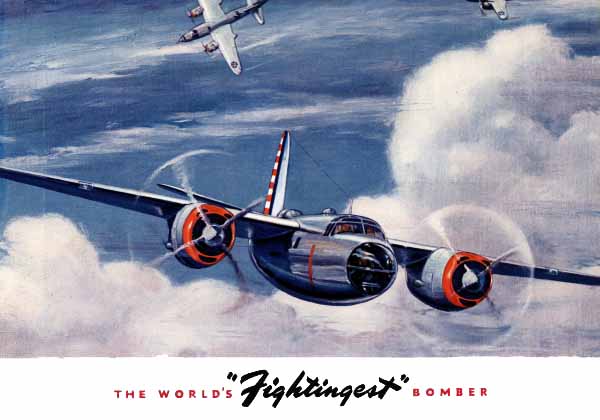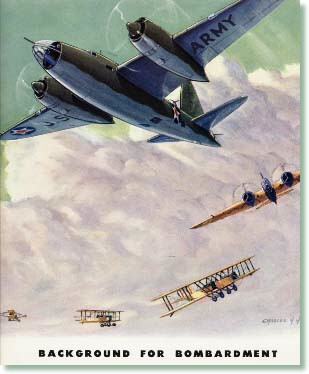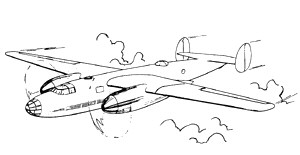![]()
The Martin B-26 Marauder
|
|
|||||||||||||||||||||
|
|
Four 30 caliber guns had been specified for the original armament, but this was increased when Martin developed a power-operated deck gun turret, the first such turret to go into American production. Self-sealing fuel tanks and 555 lbs. of armor were specified for a B-26A version added on option to the original contract, and by 30th September 1940, the Army decided to include these features on all B-26's under construction. Although the first B-26 had yet to fly, the orders for 139 B-26A's on 16th September and 791 B-26B's on 28th September 1940 brought the total on order to 1,131 aircraft. No prototype, as such, was planned because of the Army's desire to get its new medium bombers into production. On 25th November 1940, chief engineer and test pilot William K. Ebel lifted 40-1361, the first B-26, on its maiden flight. Its streamlined form, from the plexiglass nose cone to the tail cone behind the single rudder, earned immediate attention as a virtual "flying torpedo". The original contract specification was for an empty weight of 19,250 lbs. and gross weight of 26,625 lbs. with a guaranteed performance of 323 m.p.h. top speed, 26,440 feet service ceiling and range of 1,800 miles. The actual B-26 aircraft weighed 21,375 lbs. empty and 27,200 lbs. gross in design condition. Top speed was 315 m.p.h. at 15,000 feet, service ceiling 25,000 feet and range was 1,000 miles at 265 m.p.h. with 3,000 lb. bomb load and 962 gallons of fuel. Maximum ferry range was 2,200 miles with 1,212 gallons. Dimensions included a wing span of 65 feet, 602 sq. ft. wing area, 56 feet length and 19 ft. 10 in. height. Effects of the high wing loading were shown in the 2,500 feet takeoff run, 12.5 minutes required to climb to 15,000 feet, and 103 m.p.h. landing speed. Armament included a 30 caliber flexible gun in the nose operated by the bombardier, two 50 caliber guns in the deck turret, another 30 caliber flexible gun at a bottom opening, and another 50 caliber flexible gun in the tail turret. The tail gunner had room enough to sit upright, unlike the prone position on the earlier B-23 and B-25 types. Ammunition supply included 1,200 30 caliber rounds and 1,200 50 caliber rounds. A pair of 2,000 lb. bombs could be accommodated in the main bomb bay, with up to 4,800 lb. of smaller bombs available if the aft bay was used. The first 113 hours of testing went well without serious incident, and in February 1941 the first four aircraft were accepted, by the Army Air Corps. At Langley Field, Virginia, the 22nd Bombardment Group (Medium) became the first to use the B-26. But of 66 Martins accepted by June, only 21 had been delivered, with 44 remaining in storage. A series of failures of the front wheel strut caused the delay in bringing the B-26 to operational status. The strut was strengthened but it was discovered that the accidents had been due to improper weight distribution. The manufacturer had to deliver the aircraft without guns, and had trimmed the new B-26's for delivery flights by carefully loading service tools and spare parts in a prescribed manner. When the Army took over, these were removed without replacement ballast. The resultant forward movement of the centre of gravity had multiplied the loads on the nose wheel, causing the accidents. Addition of the guns corrected the problem, and in October 1941 Martin's production lines completed the original contract and delivered the first B-26A, 41-7345. This model differed from the first mainly by provision for an extra ferry tank in the rear bomb bay. Thirty had the R-2,800-5 Wasps, but 109 delivered with the R-2,800-39 of identical power were known as the B-26A- 1. Weight had increased to 21,741 lbs. empty, 28,367 lbs. gross, and ferry range to 2,600 miles with 1,462 gallons. In 1942, many of the original B-26's were fitted with the extra ferry tanks, and the B-26 and B-26A mingled in service. These Martins had received the name "Marauder" in October 1941. Some ships had replaced the 30 caliber nose gun with a 50 caliber weapon. Fifty-two B-26A's, serials FK1O9 to FK16O, were assigned to the Royal Air Force with the name "Marauder I". By the time production of the B-26A was completed in April 1942, the Marauder had entered combat.
|
||||||||||||||||||||
|
|||
|
|
|
||

Copyright(c) 2006 320th B.G. Reunion Association. All rights reserved.




















 The B-26 Beginnings.
The B-26 Beginnings. Army Air Corps issues Specification C-213
Army Air Corps issues Specification C-213

